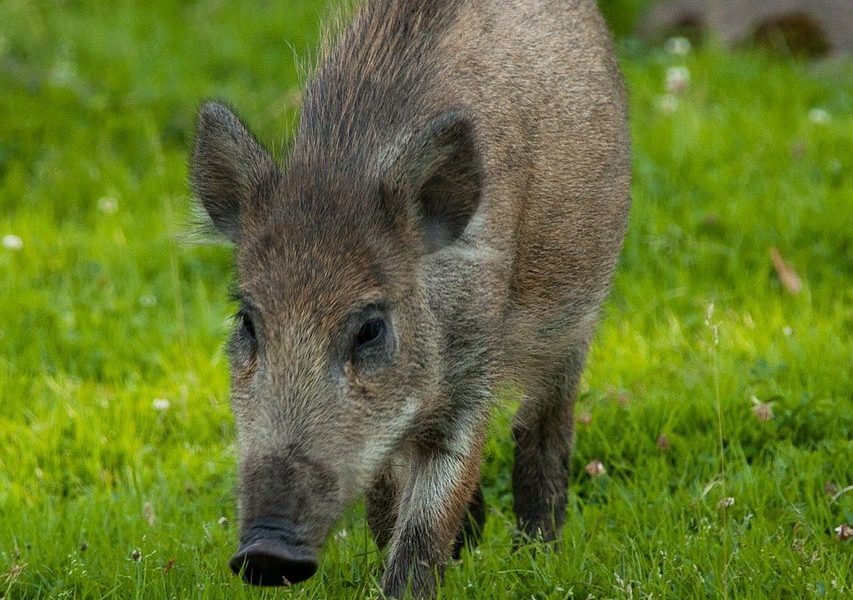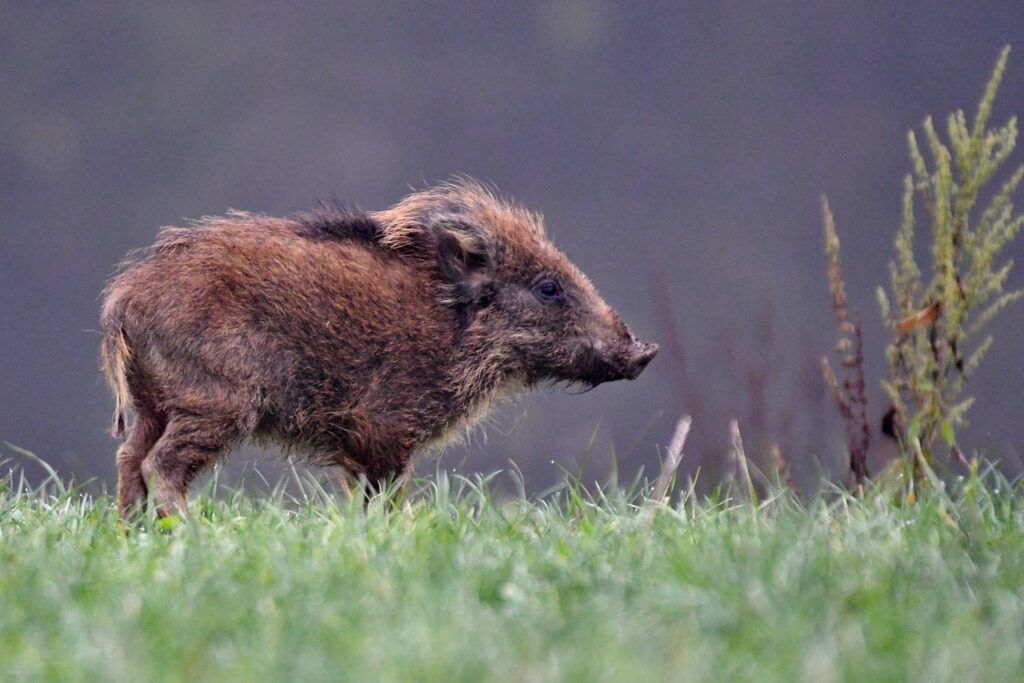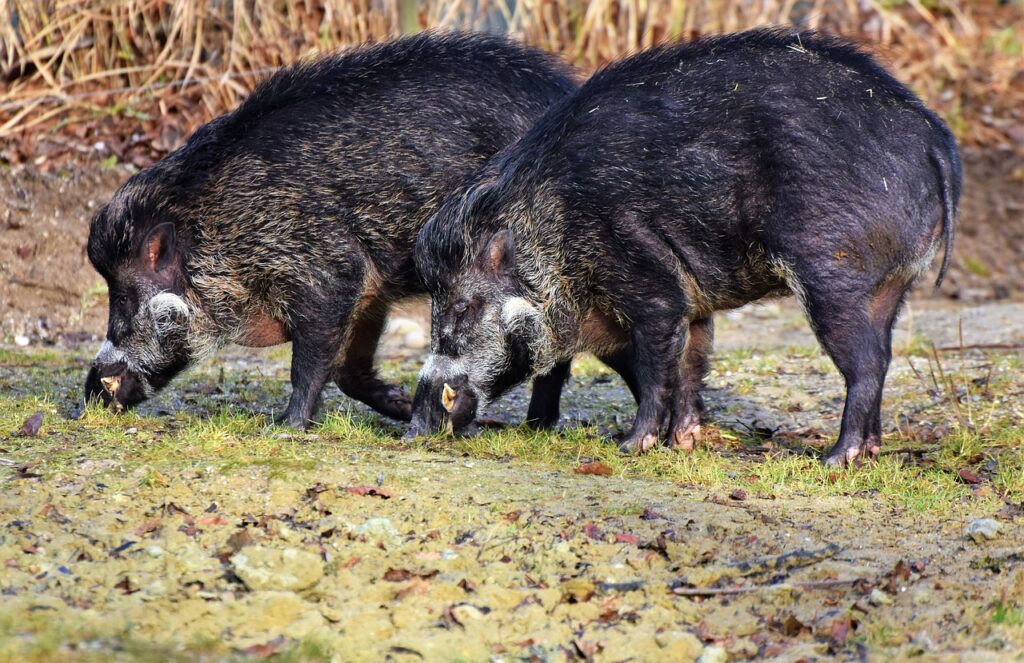
Feral hogs in Florida are also referred to as wild hogs or swine. Each name is referring to the same thing. These hogs are intrusive and free-ranging originally from livestock, Eurasian wild boar, and a crossbreed of the two.
Should you see a wild or feral hog in your neighborhood, you’ll never want to see one again. And if that hog decides to forage in your yard for a while, you will undoubtedly want to call on a feral hog removal company you can trust. World Class Wildlife Removal relocates the wild hog, keeping you and your family safe.
If you notice a feral hog hanging around your home or rooting in your backyard, make that call to World Class Wildlife Removal ASAP.
Feral Hog Description
All wild or feral hogs look similar. They are stocky builds with long snouts tusks that are actually canine teeth. They can reach around 150 lbs or more and measure five to six feet in length. Some may be leaner; some may have more wiry hair, and they vary in color.
Eurasian Wild Boars are usually taller, weigh the same as wild hogs, with coarse long hair bristles, larger heads, and snouts. However, the ears are smaller and more upright. The hair is ordinarily brown at the base and tipped with white.
Feral Livestock Hogs are often solid black, white, and reddish-brown with hair either in solid or mottled patterns across the body.
The Crossbreeds are of various colors and sizes, all within the range of feral hogs.
The Feral Hogs Diet
The diet of the feral hog is a significant concern for the state of Florida. The University of Florida has published a study on wild hogs that states the following:
“Wild hogs are omnivorous, opportunistic feeders. The list of foods hogs eat is diverse and includes grass, forb, and woody plant stems, roots, tubers, leaves, seeds, fruits, and fungi.”
Because this diet is not a part of the natural ecosystem planned for the Florida terrain, it creates a significant loss in the environment for plants and animals. It is kind of like having a football team show up at your house and clean your food supply out. Then imagine that never stopping until they are blocked. Someone is going to have lacked, while they have had plenty.

Feral Hog Dangers
It is no wonder feral hogs like Florida. They have inadequate cooling mechanisms to deal with fluctuating temperatures. Therefore, they need swamps, marshes, and muddy areas to wallow in for regulating body temperature. However, wallowing destroys small ponds and stream banks. That can affect water quality.
Feral hogs present several dangers to the environment, other animals, and humans. These hogs were never meant to be wild and, as such, developed their own set of survival skills. For this article, we can break the dangers down into those three categories.
The Environment:
The environment is significantly altered with the increase in the feral hog population. When they root for food, hogs use their snouts to turn the soil and uproot plants. In fact, they consume much more plant material than animal material. With the great need for more and more food, these wild animals will venture onto agricultural lands and plantations devouring crops at an alarming rate.
The loss of agricultural production exceeds two billion dollars per year in the United States.
And while our agricultural areas are decreasing, that only pushes the population of feral hogs closer and closer to residential parts of the state. No one wants that.
Also, when the hogs rub to scratch and the males mark trees with their tusks, they become a danger to trees and especially sapling trees in the area.
Other Animals:
These wild animals are not native to Florida, so they are considered invasive species. The feral hog will damage the Florida terrain with disruption of the natural ecosystem and modify the chemistry of the soil. That could eventually be detrimental to the other wildlife of Florida. Here are some examples of the devastation caused by feral hogs.
- They will take from game feeders positioned for deer, turkey, and other wildlife, leaving them with less food.
- Rooting for food, they use their snouts to turn the soil and uproot insects and animals.
- They consume plenty of worms, insects, crustaceans, mollusks, fish, small birds, mammals, reptiles, and amphibians, depriving the area of these animals.
Human Interaction:
Finally, they carry several diseases which transmit to humans and other animals alike. Again, according to UF’s report,
“Hogs have been known to carry dozens of such pathogens, including cholera, pseudorabies, brucellosis, tuberculosis, salmonellosis, anthrax, ticks, fleas, lice, and various flukes and worms. Although these pathogens and parasites typically do not present a serious threat to people, they do threaten livestock. Millions of dollars are spent each year to keep livestock safe from diseases and parasites spread by wild hogs.”
Knowing the damage created by feral hogs, you will want to call the experts for immediate removal. Contact World Class Wildlife Removal, and we will be right out to trap and relocate the animal.

What You Can Do About Feral Hogs in Florida
We know it can be a frightening sight to see such a large wild animal on your property. So, when the shock wears off from the view of a giant pig in your yard or on your property, you should know a few details to deal with the dangerous situation.
- Never try to relocate the feral hog on your own. They can be a real danger to humans and pets.
- Contact your local wildlife removal professionals for immediate removal procedures to begin.
- Attempt to “hog-proof” your property with the aid of your local wildlife removal professionals.
- Work with neighbors to avoid allowing wild hogs into the area. Cooperation is critical in keeping neighborhoods safe.
- Contact your local wildlife commission for permissions and sighting records. It is critical to track the movement of these feral animals to prevent further damage.
Feral Hogs Removed in Florida
The most effective way to remove feral hogs from your property is to have them professionally removed by an experienced wildlife trapper. World Class Wildlife Removal is a Florida company well acquainted with Florida’s extensive wildlife, including feral hogs.
Here are some of the steps we will take to get the hog off your lawn and restore the calm in your home.
- First, we will identify the area the hog likes to graze and where it beds down.
- Then we will pre-bait to get the swine used to the offerings.
- Our professionals will then choose the appropriate trap according to the size and number of hogs on the premises.
- As we advance, we will monitor the traps and adjust the process as necessary.
In the part of the trapping, patience and perseverance is a virtue. You may want to keep kids and pets out of the area and warn the neighbors as well. Your family’s safety is our biggest concern. That is precisely why we handle the feral hog situation for you.
At World Class Wildlife Removal, we hope you never have to worry about a feral hog in your yard. But if you do, we will be there often within the hour to assess the situation and make a plan for removal.
Contact our friendly and reassuring team to World Class Wildlife Removal for feral hog removal and any other nuisance pest in your area of Florida.
